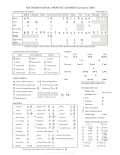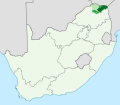The voiced labiodental nasal is a type of consonantal sound. The symbol in the International Phonetic Alphabet that represents this sound is ⟨ɱ⟩. The...
12 KB (917 words) - 10:00, 9 August 2024
The voiceless labiodental nasal (stop) is a type of consonantal sound, used in some spoken languages. The symbol in the International Phonetic Alphabet...
2 KB (261 words) - 17:05, 25 August 2024
labiodental, less ambiguously rendered as [fˠʷ]. The labiodental click is an allophonic variant of the (bi)labial click. The only common labiodental sounds...
10 KB (839 words) - 22:33, 9 November 2024
List of consonants (section Labiodental consonants)
[ʬ] labiodental approximant [ʋ] labiodental nasal [ɱ] (symphony) voiced labiodental fricative [v] (van) Voiced labiodental plosive Voiced labiodental affricate...
26 KB (2,136 words) - 18:12, 9 February 2024
oral, with no nasal outlet, the airflow is blocked entirely, and the consonant is a plosive. Its place of articulation is labiodental, which means it...
3 KB (287 words) - 22:37, 7 December 2023
Kukuya language (section The labiodental nasal)
Congolese plateau. It is the only language known to have a phonemic labiodental nasal /ɱ/. The name of the language comes from the word kuya "plateau"....
8 KB (785 words) - 09:37, 1 March 2024
versions. /ɱ/ is the rarest voiced nasal to be phonemic, its mostly an allophone of other nasals before labiodentals and currently there is only 1 reported...
21 KB (2,442 words) - 09:09, 6 November 2024
Labial-velar nasal (ŋ͡m) Labiodental approximant (ʋ) Labiodental consonant Labiodental ejective fricative (fʼ) Labiodental flap (ⱱ) Labiodental nasal (ɱ) Lateral...
13 KB (1,196 words) - 14:10, 20 February 2024
based on the letter M. Its minuscule ɱ is used to transcribe a voiced labiodental nasal in the International Phonetic Alphabet. In Americanist phonetic transcription...
1 KB (104 words) - 18:14, 9 March 2024
oral, with no nasal outlet, the airflow is blocked entirely, and the consonant is a plosive. Its place of articulation is labiodental, which means it...
3 KB (261 words) - 03:59, 30 May 2024
Palatal nasal Nasal palatal approximant Labiodental nasal, which may be an approximant in the one language in which it is phonemic Voiceless nasal glottal...
5 KB (417 words) - 19:59, 1 August 2024
The voiceless labiodental affricate ([p̪͡f] in IPA) is a rare affricate consonant that is initiated as a labiodental stop [p̪] and released as a voiceless...
7 KB (583 words) - 17:20, 21 October 2024
The voiced labiodental fricative is a type of consonantal sound used in some spoken languages. The symbol in the International Phonetic Alphabet that...
20 KB (924 words) - 09:28, 26 September 2024
Palatal nasal Nasal labio-velar approximant Labiodental nasal, which may be an approximant in the one language in which it is phonemic Voiceless nasal glottal...
8 KB (610 words) - 13:48, 7 September 2024
The voiced velar nasal, also known as eng, engma, or agma (from Greek ἆγμα âgma 'fragment'), is a type of consonantal sound used in some spoken languages...
32 KB (1,321 words) - 05:10, 13 November 2024
"M with hook", letter used in the International Phonetic Alphabet Labiodental nasal consonantal sound, the sound transcribed by that letter Meng (designer)...
871 bytes (153 words) - 16:32, 12 September 2021
The voiced labiodental approximant is a type of consonantal sound, used in some spoken languages. It is something between an English /w/ and /v/, pronounced...
18 KB (893 words) - 07:39, 22 October 2024
be' m m bilabial nasal English man, French main 'hand' F ɱ labiodental nasal Spanish infierno, Hungarian kámfor n n alveolar nasal English, Spanish and...
22 KB (186 words) - 20:27, 29 August 2023
The voiceless labiodental fricative is a type of consonantal sound used in a number of spoken languages. The symbol in the International Phonetic Alphabet...
20 KB (901 words) - 04:40, 27 May 2024
/c/ was spelled ⟨ky⟩ or ⟨ty⟩. Both ⟨n⟩ and ⟨m⟩ are pronounced as a labiodental nasal [ɱ] before ⟨f⟩. Tone is not written unless the word is ambiguous....
29 KB (2,187 words) - 09:54, 11 July 2024
included in the chart, ⟨ɱ⟩ was mentioned as an optional letter for the labiodental nasal. ⟨ɹ⟩ was still designated as the "provisional" letter for the alveolar...
131 KB (8,661 words) - 16:15, 11 August 2024
The voiced retroflex nasal is a type of consonantal sound, used in some spoken languages. The symbol in the International Phonetic Alphabet that represents...
8 KB (644 words) - 18:04, 27 August 2024
There are five vowel sounds and two high vowels in Tshivenḓa. A labiodental nasal /ɱ/ sound appears in prenasalised consonant sounds. Labiovelar sounds...
15 KB (824 words) - 15:25, 2 November 2024
m m Voiced bilabial nasal 115 ɱ m" m> mv \mj m> mD M M F Voiced labiodental nasal 116 n n n n n n n n n n Voiced alveolar nasal 117 ɳ nr) n( nr \n. n<...
44 KB (632 words) - 15:02, 12 April 2024
the latter is the case of the labiodental flap, symbolized by a right-hook v in the IPA: . A convention for the labiodental flap does not yet exist in X-SAMPA...
53 KB (539 words) - 19:57, 16 October 2024
Tap and flap consonants (redirect from Nasal flap)
however, he used the term flap in all cases. Subsequent work on the labiodental flap has clarified the issue: flaps involve retraction of the active...
15 KB (1,673 words) - 20:16, 21 October 2024
Labiodental consonants are made by the lower lip rising to the upper teeth. Labiodental consonants are most often fricatives while labiodental nasals...
40 KB (5,267 words) - 04:46, 21 March 2024
The voiced alveolar nasal is a type of consonantal sound used in numerous spoken languages. The symbol in the International Phonetic Alphabet that represents...
35 KB (1,641 words) - 12:51, 23 August 2024
The voiced linguolabial nasal is a type of consonantal sound used in some spoken languages. The symbol in the International Phonetic Alphabet that represents...
1 KB (164 words) - 09:22, 11 July 2024
Labiodental consonants are made by the lower lip rising to the upper teeth. Labiodental consonants are most often fricatives while labiodental nasals...
81 KB (10,586 words) - 09:03, 15 November 2024








